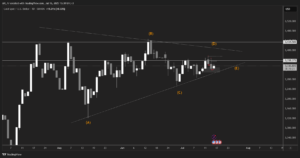Crude oil prices rose by 2.13% to settle at 6950 points, driven by expectations of peak summer consumption and OPEC+ production cuts. However, gains were limited by increased production from other producers and market caution ahead of upcoming elections. The Energy Information Administration (EIA) reported that oil production and demand for key products rose to a four-month high in April, supporting prices. Additionally, traders are watching the impact of the Atlantic hurricane season on oil and gas production and consumption, as Hurricane Berel begins.
In the speculative market, money managers increased their net long positions in NYMEX crude futures and options by 53,339 contracts to 213,177 during the week ended June 25, according to the Commodity Futures Trading Commission (CFTC). The EIA also reported that US crude oil and gasoline inventories rose while distillate inventories fell in the week ended June 21. Crude oil inventories rose by 3.6 million barrels to 460.7 million barrels, against expectations of a 2.9 million-barrel decline. Crude stocks at the Cushing, Oklahoma, delivery hub fell by 226,000 barrels. Refinery throughput (TADAWUL:2030) fell by 233,000 barrels per day, and refinery utilization rates fell by 1.3 percentage points.
NYMEX crude futures rose during Asian trading on Tuesday. According to the New York Mercantile Exchange, NYMEX crude futures for August are trading at USD83.53 per barrel as of this writing, up 0.18%. Earlier trading saw a high of USD83.61 per barrel. Crude oil may find support at USD80.51 and resistance at USD83.64.
Markets Seek New Clues on Future of European Interest Rates
The euro fell in European trading on Tuesday against a basket of major and minor currencies, for the first time in the past four days against the US dollar, giving up a three-week high due to profit-taking and corrective activity, as well as a reluctance to build new buying positions ahead of the release of key eurozone inflation data for June.
European Central Bank President Christine Lagarde is due to speak later today. Investors are hoping to get more clues about the possibility of further cuts to European interest rates before the end of this year.
Price Outlook
- Euro exchange rate today: The euro fell against the dollar by 0.25% to (1.0713$), from the opening price of (1.0740$), and hit a high of (1.0742$).
- The euro ended Monday’s trading 0.3% higher against the dollar, for its third consecutive daily gain, hitting a three-week high of $1.0776 as investors breathed a sigh of relief after preliminary results from the first round of presidential elections in France emerged.
- The results showed the far-right alliance led by Marine Le Pen ahead of other alliances but by a smaller margin than some polls had predicted.
- At the moment, the results of the first round do not provide much certainty about the composition of parliament, and the second round scheduled for next weekend is really a big event with risks attached.
- By 10:00 GMT, the annual eurozone consumer price index is due to be released, with market forecasts pointing to a rise of 2.5% in June from 2.6% in May, and the core figure is expected to rise by 2.8% from 2.9% the previous month.
- At 14:30 GMT, ECB President Christine Lagarde is scheduled to participate in a panel discussion entitled “Policy Committee” at the ECB’s Central Banking Forum in Sintra, Portugal.
- If the inflation data comes in cold and below market expectations, the euro’s current losses in the foreign exchange market will worsen.
- Less hawkish comments from Lagarde would add further downward pressure on the single currency as it retests its lows against the US dollar in nearly a month.
Lagarde: “Central” European is in no rush to cut interest rates further
Christine Lagarde, the president of the European Central Bank, said on Monday that the bank needs more time to conclude that inflation is firmly on track to its 2% target and that good economic developments suggest that a rate cut is not urgent. The ECB cut interest rates for the first time in June after the most aggressive tightening cycle, but refrained from committing to any further moves, arguing that the high level of uncertainty makes it difficult to announce a second cut. “It will take some time to gather enough data to be sure that the risks of inflation above target have receded,” Lagarde said at the ECB’s central bank forum. “The strong labor market means we can afford to take the time to gather new information,” she added.
The ECB is trying to balance the uncertainty over inflation with the weakness of growth. The uncertainty may justify caution in cutting interest rates, but the ongoing economic weakness strengthens the case for monetary easing, pulling the ECB in two opposite directions. Lagarde acknowledged this dilemma, warning that the bloc is not guaranteed to avoid a recession, despite the modest uptick in growth last quarter. “A soft landing is still not guaranteed… We also have to take into account the fact that growth expectations are still uncertain,” she said.
Growth indicators in recent weeks have come in on the weaker side of expectations, challenging the widespread view that the year-and-a-half economic recession is over and the recovery is taking hold. But investors are still betting that inflation concerns will outweigh recession fears and that the ECB will be very slow to cut interest rates, especially after the US Federal Reserve has shown its patience. Banks are now pricing in one or two more cuts this year and only four between now and the end of 2025. This is largely because inflation expectations remain very uncertain. Price growth is expected to hover around 2.5% for the rest of the year before easing back to the ECB’s target of 2% by the end of 2025.
The Dollar Rises Supported by US Treasury Bond Yields
The dollar rose on Tuesday, supported by rising US Treasury yields, after the Japanese yen fell to its lowest level since 1986. The benchmark 10-year Treasury yield rose about 14 basis points to 4.479%, with analysts attributing the move to expectations of a Donald Trump victory in the US presidency and increased tariffs and government borrowing. As the dollar rose, the euro retreated from a slight gain as the results of the first round of the French elections emerged in line with polls. The European currency traded at 1.0735 against the dollar.
The Japanese yen fell to 161.72 against the dollar on Monday, its weakest level in nearly 38 years, continuing its decline driven primarily by the wide gap in interest rates between the US and Japan. The yen was trading at 161.55 against the dollar in Asia on Tuesday.
Disclaimer: This article is not investment advice or an investment recommendation and should not be considered as such. The information above is not an invitation to trade and it does not guarantee or predict future performance. The investor is solely responsible for the risk of their decisions. The analysis and commentary presented do not include any consideration of your personal investment objectives, financial circumstances, or needs.





